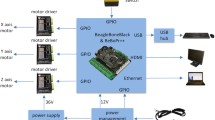Abstract.
In this paper we are concerned with the design of a small low-cost, low-field multipolar magnet for Magnetic Resonance Imaging with a high field uniformity. By introducing appropriate variables, the considered design problem is converted into a global optimization one. This latter problem is solved by means of a new derivative free global optimization method which is a distributed multi-start type algorithm controlled by means of a simulated annealing criterion. In particular, the proposed method employs, as local search engine, a derivative free procedure. Under reasonable assumptions, we prove that this local algorithm is attracted by global minimum points. Additionally, we show that the simulated annealing strategy is able to produce a suitable starting point in a finite number of steps with probability one.
Similar content being viewed by others
References
Bertsekas, D.P.: Constrained Optimization and Lagrange Multipliers Methods. Academic Press, New York, 1982
Brachetti, P., De Felice Ciccoli, M., Di Pillo, G., Lucidi, S.: A new version of the Price’s algorithm for global optimization. J. Global Optim. 10, 165–184 (1997)
Cho, Z., Jones, J.P., Singh, M.: Foundations of Medical Imaging. John Wiley and Sons, New York, 1993
Chubar, O., Elleaume, P., Chavanne, J.: A 3d magnetostatics computer code for insertion devices. J. Synchrotron Radiation 5, 481–484 (1998)
Cirio, L., Lucidi, S., Parasiliti, F., Villani, M.: A global optimization approach for the synchronous motors design by finite element analysis. Int. J. Appl. Electromagnetics and Mechanics 16, 13–27 (2002)
Conn, A.R., Gould, N.I.M., Toint, Ph.: Trust-region methods. MPS-SIAM Series on Optimization. SIAM publications, Philadelphia, PA, USA, 2000, p. 22
Czyzyk, J., Mesnier, M., Moré, J.: The neos server. IEEE J. Comput. Sci. Engin. 5, 68–75 (1998)
Daidone, A., Parasiliti, F., Villani, M., Lucidi, S.: A new method for the design optimization of three-phase induction motors. IEEE Trans. Magnetics 34, 2932–2935 (1998)
Dolan, E.: The neos server 4.0 administrative guide. Tech. Memorandum ANL/MCS-TM-250, Mathematics and Computer Science Division, Argonne National Laboratory, Argonne, IL, USA, 2001
Elleaume, P., Chubar, O., Chavanne, J.: Computing 3d magnetic field from insertion devices. In: Proceeding of the PAC97 Conference May, 1997, pp. 3509–3511
Fourer, R., Gay, D., Kernighan, B.: AMPL a modeling language for mathematical programming. Boyd & Fraser publishing company, Massachusetts, 1993
Garcia, I., Ortigosa, P.M., Casado, L.G., Herman, G.T., Matej, S.: Multidimensional optimization in image reconstruction from projections. In: Developments in Global Optimization, I. M. Bomze, T. Csendes, R. Horst, and P. Pardalos, (eds.), Kluwer, Dordrecht, 1997, pp. 289–300
García-Palomares, U.M., Rodríguez, J.F.: New Sequential and Parallel Derivative-Free Algorithms for Unconstrained Minimization. SIAM J. Optim. 13, 79–96 (2002)
Grippo, L., Lampariello, F., Lucidi, S., Sciandrone, M.: Global convergence and stabilization of unconstrained minimization methodswithout derivatives. J. Optim. Theory Appl. 56, 385–406 (1988)
Gropp, W., Moré, J.: Optimization environments and the neos server. In: Approximation Theory and Optimization, M. Buhmann and A. Iserles, (eds.), Cambridge University Press, 1997, pp. 167–182
Haacke, E.M., Brown, R.W., Thompson, M.R., Vankatesan, R.: Magnetic Resonance Imaging: Physical Principles and Sequence Design. John Wiley and Sons, New York, 1999
Hendrix, E., Ortigosa, P., Garcia, I.: On success rates for controlled random search. J. Global Optim. 21, 239–263 (2001)
Liang, Z., Lauterbur, P.C.: Principles of Magnetic Resonance Imaging: A Signal Processing Approach. IEEE Press, 2000
Liuzzi, G., Lucidi, S., Placidi, G., Sotgiu, A.: A magnetic resonance device designed via global optimization techniques. TR 09-02, Department of Computer and System Sciences ‘‘A. Ruberti’’, University of Rome ‘‘La Sapienza’’, Rome, Italy, 2002
Lucidi, S., Piccioni, M.: Random tunneling by means of acceptance-rejection sampling for global optimization. J. Optim. Theory Appl. 62, 255–279 (1989)
Lucidi, S., Sciandrone, M.: On the global convergence of derivative free methods for unconstrained optimization. SIAM J. Optim. 13, 97–116 (2002)
Lucidi, S., Sciandrone, M.: A derivative-free algorithm for bound constrained optimization. Comput. Optim. Appl. 21 (2), 119–142 (2002)
Nishimura, D.G.: Magnetic Resonance Imaging. MRSRL Press
Price, W.L.: Global optimization algorithms for a CAD workstation. J. Optim. Theory Appl. 55, 133–146 (1983)
Price, W.L., Woodhams, F.: Optimising accelerator for CAD workstations. IEEE Proc. 135, 214–221 (1988)
Solis, F.J.-B., Wets, R.J.: Minimization by random search techniques. Math. Oper. Res. 6, 19–30 (1981)
Wolfram Research Inc.: Mathematica, http://www.wolfram.com/, 2003
Author information
Authors and Affiliations
Corresponding author
Additional information
This work was supported by CNR/MIUR Research Program “Metodi e sistemi di supporto alle decisioni”, Rome, Italy.
Mathematics Subject Classification (1991):65K05, 62K05, 90C56
Rights and permissions
About this article
Cite this article
Liuzzi, G., Lucidi, S., Piccialli, V. et al. A magnetic resonance device designed via global optimization techniques. Math. Program., Ser. A 101, 339–364 (2004). https://doi.org/10.1007/s10107-004-0528-5
Received:
Accepted:
Published:
Issue Date:
DOI: https://doi.org/10.1007/s10107-004-0528-5




